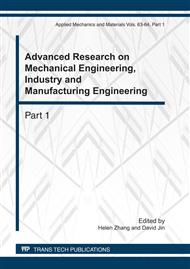p.193
p.197
p.201
p.205
p.209
p.214
p.218
p.222
p.226
Research on Control Theory of Belt Conveyor
Abstract:
Dynamic performance of belt conveyor has become increasingly prominent, so accurate design techniques should be adopted, thus the dynamic simulation methods are required to research precisely the starting performances of. This paper selects the viscoelasticity model suiting to the belt by comparing dynamic performance of some kinds of models, and develops simulation model of driving device with closed-loop controlling. The simulation model with simple structure, the high stability, the reliable working and the convenient adjustment indicates that rotation speed and output moment of motor change with load and working time, therefore really reflectes dynamic work process of the driving device. Simulation results are more close to practice.
Info:
Periodical:
Pages:
209-213
Citation:
Online since:
June 2011
Authors:
Keywords:
Price:
Сopyright:
© 2011 Trans Tech Publications Ltd. All Rights Reserved
Share:
Citation:


